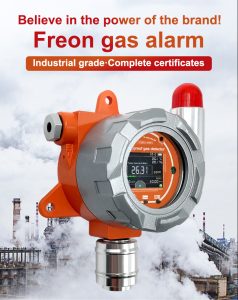Workplace safety is of utmost importance to protect employees and prevent accidents or health hazards. Many industries and workplaces involve the presence of hazardous gases that pose significant risks to human health and safety. In such environments, the early detection of these gases is crucial to minimize the potential harm. Gas sensors play a vital role in ensuring workplace safety by detecting and alerting individuals to the presence of hazardous gases. In this article, we will explore the importance of gas sensors in detecting various hazardous gases and their contribution to creating a safe working environment.
The Importance of Gas Sensors in Workplace Safety:
- Detection of Flammable Gases: Flammable gases, such as methane, propane, and hydrogen, are commonly found in industries like manufacturing, petrochemicals, and construction. Gas sensors equipped with flammable gas detectors can quickly identify the presence of these gases, triggering an alarm to alert workers. This early detection allows personnel to evacuate the area, shut down equipment, and take appropriate measures to prevent explosions or fires, safeguarding lives and property.
- Monitoring Toxic Gases: Certain industries produce toxic gases, including hydrogen sulfide, ammonia, and chlorine. Exposure to these gases can lead to severe health issues, including respiratory problems, chemical burns, or even death. Gas sensors with toxic gas detectors continuously monitor the air quality and provide real-time data on gas concentrations. When predetermined thresholds are exceeded, alarms are triggered, enabling workers to take immediate action, such as wearing personal protective equipment (PPE), evacuating, or shutting down operations until the situation is resolved.
- Indoor Air Quality Monitoring: Apart from specific industrial gases, monitoring general indoor air quality (IAQ) is critical for maintaining a healthy workplace. Poor IAQ can result from inadequate ventilation, high levels of carbon dioxide (CO2), or accumulation of volatile organic compounds (VOCs) from office equipment or cleaning products. Gas sensors equipped with IAQ detectors help identify these issues and provide feedback on ventilation and air quality parameters. By monitoring CO2 levels and VOC concentrations, employers can take necessary actions to improve ventilation, introduce air purifiers, or limit the use of chemicals, creating a healthier work environment for their employees.
- Early Detection of Oxygen Depletion: In confined spaces or locations where oxygen is used up rapidly, workers may experience oxygen depletion, leading to asphyxiation and loss of consciousness. Gas sensors that monitor oxygen levels alert workers when the concentration falls below safe levels. This allows them to evacuate the affected area promptly or use appropriate breathing apparatus to prevent accidents and injuries.
- Integration with Safety Systems: Gas sensors can be integrated with safety systems, such as fire alarm systems, ventilation control systems, or emergency shut-off systems. When gas sensors detect hazardous gas levels, they can trigger alarms, activate ventilation to dilute the gas concentration, or automatically shut down equipment to prevent further risks. This integration enhances the overall safety infrastructure and ensures a swift response to potential threats, reducing the likelihood of accidents and injuries.
Best Practices for Gas Sensor Implementation:
To maximize the effectiveness of gas sensors in promoting workplace safety, certain best practices should be followed:
- Regular Maintenance and Calibration: Gas sensors should be regularly maintained and calibrated to ensure accurate and reliable functioning. Routine inspections, sensor cleaning, and calibration checks help maintain the performance and accuracy of gas detection systems.

- Proper Placement of Gas Sensors: Strategic placement of gas sensors is crucial to achieve optimal coverage and early detection. Sensors should be placed in areas where gases are likely to accumulate or where there is a higher risk of exposure. This includes near potential leak sources, storage areas, or confined spaces.
- Employee Training and Awareness: Employees should be trained on the proper use and understanding of gas sensors. They should be educated about the different types of gases, alarm signals, and appropriate response procedures. Regular safety drills and refresher training sessions ensure that employees are well-prepared to respond effectively in case of emergencies.
- Integration with Building Management Systems: Gas sensors can be integrated with building management systems to enable centralized monitoring, data analysis, and control. This integration provides better oversight of workplace safety, allowing immediate response and intervention when necessary.
Conclusion:
Gas sensors play a vital role in ensuring workplace safety by providing early detection and measurement of hazardous gases. From flammable gases to toxic chemicals and IAQ monitoring, gas sensors contribute significantly to creating a safe working environment. By alerting workers and triggering appropriate safety measures, gas sensors help prevent accidents, protect lives, and minimize health risks. Implementing gas sensors along with proper maintenance, employee training, and system integration enhances overall safety measures, making workplaces safer and more secure for everyone involved. Prioritizing workplace safety through the use of gas sensors demonstrates a commitment to protecting employees' well-being and maintaining a healthy work environment.
 : +86 155 8830 2704
: +86 155 8830 2704 : jxdziot@gmail.com
: jxdziot@gmail.com
